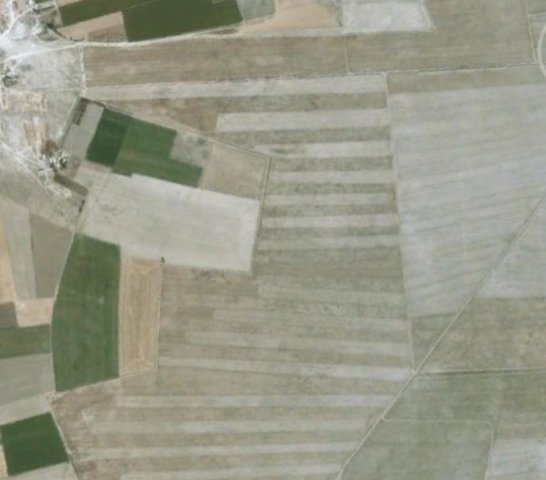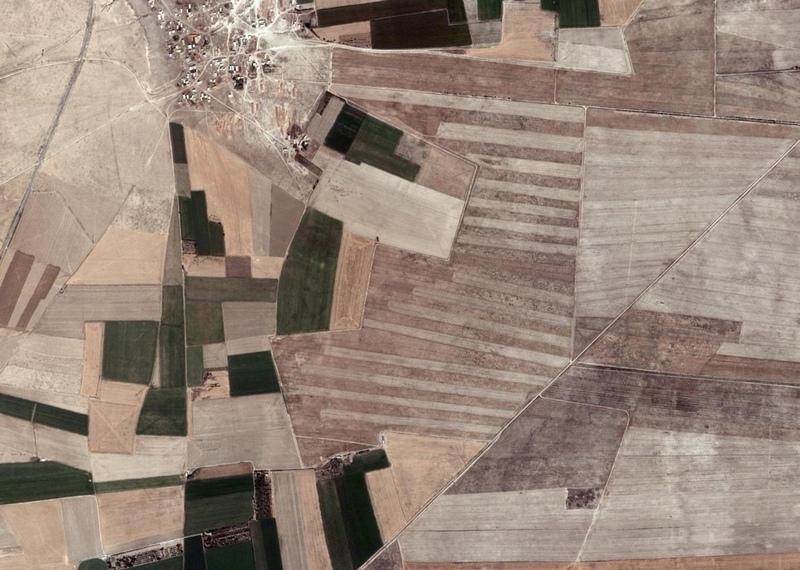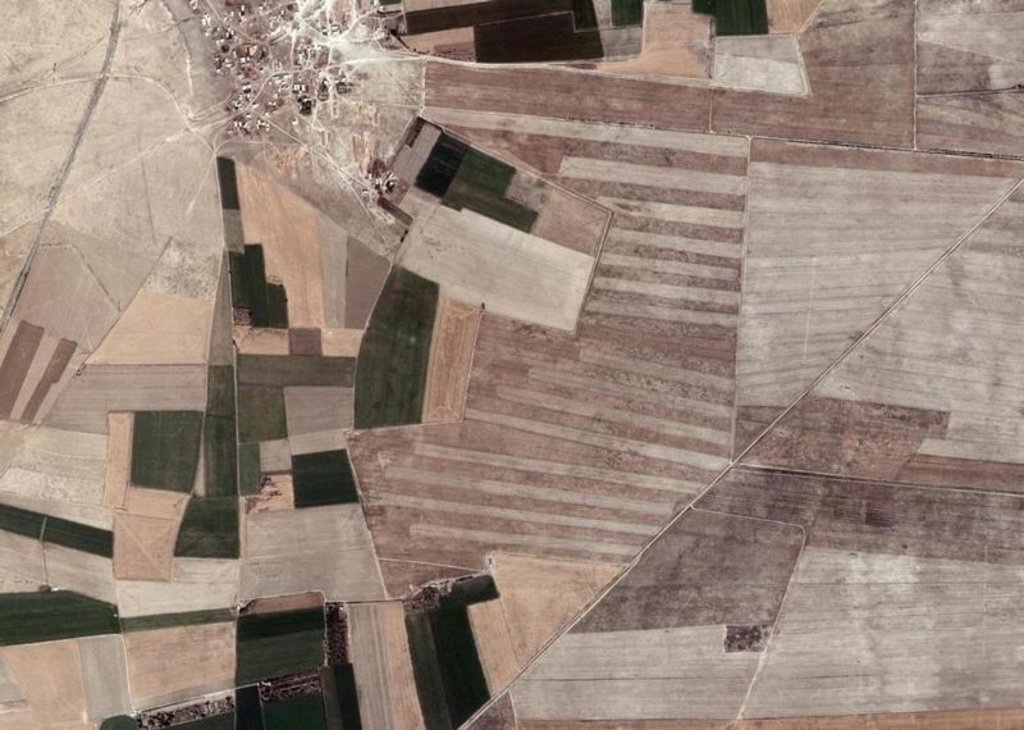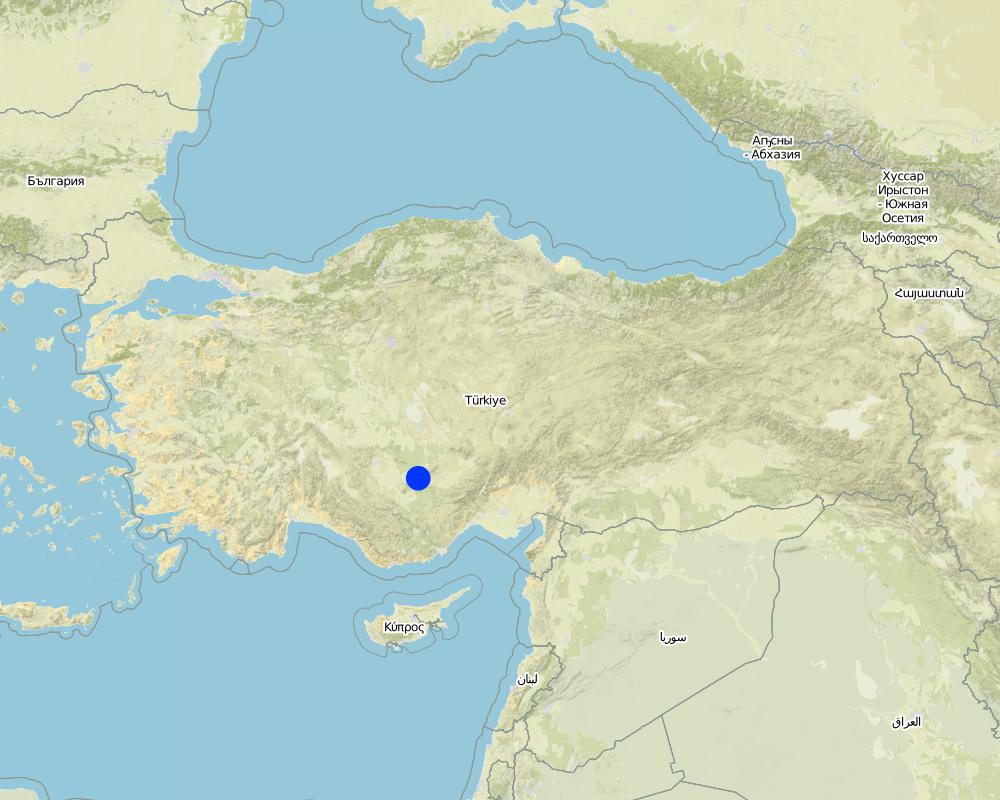Strip farming [Türkiye]
- Creation:
- Update:
- Compiler: Mehmet Zengin
- Editor: –
- Reviewers: Fabian Ottiger, Alexandra Gavilano
Seritvari Tarim (Turkish)
technologies_995 - Türkiye
View sections
Expand all Collapse all1. General information
1.2 Contact details of resource persons and institutions involved in the assessment and documentation of the Technology
1.3 Conditions regarding the use of data documented through WOCAT
The compiler and key resource person(s) accept the conditions regarding the use of data documented through WOCAT:
Yes
1.5 Reference to Questionnaire(s) on SLM Approaches (documented using WOCAT)

Crop Production [Türkiye]
Adopting of the strip cropping-fallow-strip cropping system by farmers, with support from local SWC specialists and state agricultural organisations.
- Compiler: Mehmet Zengin
2. Description of the SLM Technology
2.1 Short description of the Technology
Definition of the Technology:
Strip farming is a kind of an agriculture method that cereals are sowed as strips which are 50 m witdh (strip-fallow-strip). Strips are perpendicular to wind direction in dropugth areas.
2.2 Detailed description of the Technology
Description:
Cereals are grown as strip-fallow to conserve the soil from the wind. Cereal strip in current year will be fallowed next year while the fallowed strip in this yaer will be cereal strip in next year. Width of the strips should be 50 m and they have to be arranged perpendicular to wind direction. So can not move the soil as a wind erosion. Plant strip conserve the soil in their original place. Aim of this method is to conserve field soil in drought area. Field soil is keeped sown in every year as strip-fallow-strip in turn. In the system there is not much input. Field can not be sown in every year due to drought, but in can not be left as fallow compleately. Otherwise barren (without plant) soil losses by the wind. For this, the farmers must be informed in the drought regions. In the drought area (<400 mm annual precipitation), to conserve the soil in the field is very important with respect to environment. Because wind erosion both carries the soil and cause siltation (sedimentation) near the settlement areas.
2.3 Photos of the Technology
2.5 Country/ region/ locations where the Technology has been applied and which are covered by this assessment
Country:
Türkiye
Region/ State/ Province:
Konya
Further specification of location:
Karapinar
Specify the spread of the Technology:
- evenly spread over an area
If precise area is not known, indicate approximate area covered:
- 10-100 km2
Map
×2.6 Date of implementation
If precise year is not known, indicate approximate date:
- 10-50 years ago
2.7 Introduction of the Technology
Specify how the Technology was introduced:
- through projects/ external interventions
3. Classification of the SLM Technology
3.2 Current land use type(s) where the Technology is applied

Cropland
- Annual cropping
Annual cropping - Specify crops:
- cereals - barley
- cereals - maize
- cereals - wheat (spring)
- fodder crops - clover
- root/tuber crops - sugar beet
Number of growing seasons per year:
- 1
Specify:
Longest growing period in days: 10Longest growing period from month to month: Oct - Jul

Grazing land
Extensive grazing:
- Nomadism
Comments:
Livestock density (if relevant):
25-50 LU /km2
Major land use problems (compiler’s opinion): Yearly precipitation (270 mm) is very low while evaporation is high (750 mm per year). Soils are shallowed by wind erosion and degradation. Additionally soil fertility is low and biomass is very poor. Plants are consumpting lots of water for growing. Strip farming is not prefered and drip irrigation is not used.
Major land use problems (land users’ perception): Irrigation water is not enough and pasture lands are very poor. The electric energy for the irrigation is very expensive.
Nomadism: sheep
3.4 Water supply
Water supply for the land on which the Technology is applied:
- rainfed
Comments:
Water supply: rainfed, full irrigation
3.5 SLM group to which the Technology belongs
- windbreak/ shelterbelt
3.6 SLM measures comprising the Technology
3.7 Main types of land degradation addressed by the Technology

soil erosion by wind
- Et: loss of topsoil
- Ed: deflation and deposition

biological degradation
- Bh: loss of habitats
- Bq: quantity/ biomass decline
- Bs: quality and species composition/ diversity decline
- Bl: loss of soil life
Comments:
Main type of degradation addressed: Et: loss of topsoil, Ed: deflation and deposition
Secondary types of degradation addressed: Bh: loss of habitats, Bq: quantity / biomass decline, Bs: quality and species composition /diversity decline, Bl: loss of soil life
Main causes of degradation: droughts (drought is geting dominant and rain decreases.)
Secondary causes of degradation: soil management (crop management is not being done properly), deforestation / removal of natural vegetation (incl. forest fires) (trees and shrups were dejayed around in early times), population pressure (Population increasing attacks to the field and yield capacitiy is decreasing.), land tenure (Field is getting fragmentated by the inheritance.), education, access to knowledge and support services (Lack of technical informaton is hindering succesful farming.)
3.8 Prevention, reduction, or restoration of land degradation
Comments:
Main goals: prevention of land degradation
Secondary goals: mitigation / reduction of land degradation
Third goal: rehabilitation / reclamation of denuded land
4. Technical specifications, implementation activities, inputs, and costs
4.1 Technical drawing of the Technology
Technical specifications (related to technical drawing):
Secondary technical functions: improvement of ground cover, increase in organic matter, increase in nutrient availability (supply, recycling,…), increase of infiltration, increase / maintain water stored in soil, increase of groundwater level / recharge of groundwater, sediment retention / trapping, sediment harvesting, reduction in wind speed, increase of biomass (quantity)
Contour planting / strip cropping
Material/ species: cereals
Quantity/ density: 450 grain
Remarks: strip-fallow-strip
Rotations / fallows
Material/ species: plants for strip cropping
Quantity/ density: normal
Remarks: strip-fallow-strip
4.2 General information regarding the calculation of inputs and costs
other/ national currency (specify):
Turkish Liras
If relevant, indicate exchange rate from USD to local currency (e.g. 1 USD = 79.9 Brazilian Real): 1 USD =:
13.0
Indicate average wage cost of hired labour per day:
17.00
4.4 Costs and inputs needed for establishment
| Specify input | Unit | Quantity | Costs per Unit | Total costs per input | % of costs borne by land users | |
|---|---|---|---|---|---|---|
| Equipment | Machine use | ha | 1.0 | 77.0 | 77.0 | |
| Plant material | Seeds | ha | 1.0 | 230.0 | 230.0 | 90.0 |
| Plant material | Seedlings | ha | 1.0 | 230.0 | 230.0 | 90.0 |
| Plant material | Fertilizer | ha | 1.0 | 307.0 | 307.0 | 90.0 |
| Plant material | Biocides | ha | 1.0 | 77.0 | 77.0 | |
| Total costs for establishment of the Technology | 921.0 | |||||
| Total costs for establishment of the Technology in USD | 70.85 | |||||
Comments:
Duration of establishment phase: 2 month(s)
4.5 Maintenance/ recurrent activities
| Activity | Timing/ frequency | |
|---|---|---|
| 1. | Sowing | Authumn / once a year |
| 2. | Fertilizing | Authumn and spring / 2 times |
| 3. | Herbicide | Spring / once a year |
| 4. | Harvest | Summer / once a year |
4.6 Costs and inputs needed for maintenance/ recurrent activities (per year)
Comments:
Machinery/ tools: tractor, plough, sowing machine, pulverizator, fertilizing machine, harvest machine
The costs were calculated according to 2008 prices.
4.7 Most important factors affecting the costs
Describe the most determinate factors affecting the costs:
Seeds and fertilizers are the most expensive inputs.
5. Natural and human environment
5.1 Climate
Annual rainfall
- < 250 mm
- 251-500 mm
- 501-750 mm
- 751-1,000 mm
- 1,001-1,500 mm
- 1,501-2,000 mm
- 2,001-3,000 mm
- 3,001-4,000 mm
- > 4,000 mm
Specifications/ comments on rainfall:
In winter
Agro-climatic zone
- semi-arid
Thermal climate class: boreal
Seven months drought in a year
5.2 Topography
Slopes on average:
- flat (0-2%)
- gentle (3-5%)
- moderate (6-10%)
- rolling (11-15%)
- hilly (16-30%)
- steep (31-60%)
- very steep (>60%)
Landforms:
- plateau/plains
- ridges
- mountain slopes
- hill slopes
- footslopes
- valley floors
Altitudinal zone:
- 0-100 m a.s.l.
- 101-500 m a.s.l.
- 501-1,000 m a.s.l.
- 1,001-1,500 m a.s.l.
- 1,501-2,000 m a.s.l.
- 2,001-2,500 m a.s.l.
- 2,501-3,000 m a.s.l.
- 3,001-4,000 m a.s.l.
- > 4,000 m a.s.l.
5.3 Soils
Soil depth on average:
- very shallow (0-20 cm)
- shallow (21-50 cm)
- moderately deep (51-80 cm)
- deep (81-120 cm)
- very deep (> 120 cm)
Soil texture (topsoil):
- coarse/ light (sandy)
- medium (loamy, silty)
Topsoil organic matter:
- low (<1%)
If available, attach full soil description or specify the available information, e.g. soil type, soil PH/ acidity, Cation Exchange Capacity, nitrogen, salinity etc.
Soil fertility is: Low - medium
Soil drainage/infiltration is: medium
Soil water storage capacity is: medium
5.4 Water availability and quality
Ground water table:
5-50 m
Availability of surface water:
poor/ none
Water quality (untreated):
poor drinking water (treatment required)
Comments and further specifications on water quality and quantity:
Ground water table 5-50m (It decreases in summer, increases in winter)
5.5 Biodiversity
Species diversity:
- low
Comments and further specifications on biodiversity:
Plant number and species are very low
5.6 Characteristics of land users applying the Technology
Market orientation of production system:
- mixed (subsistence/ commercial)
Off-farm income:
- less than 10% of all income
Relative level of wealth:
- poor
- average
Level of mechanization:
- mechanized/ motorized
Indicate other relevant characteristics of the land users:
Population density: 10-50 persons/km2
Annual population growth: 0.5% - 1%
70% of the land users are average wealthy and own 30% of the land.
Level of mechanization: Mechanised (Every kind of machine is used )
5.7 Average area of land used by land users applying the Technology
- < 0.5 ha
- 0.5-1 ha
- 1-2 ha
- 2-5 ha
- 5-15 ha
- 15-50 ha
- 50-100 ha
- 100-500 ha
- 500-1,000 ha
- 1,000-10,000 ha
- > 10,000 ha
Comments:
Average area of land owned or leased by land users applying the Technology: 15-50 ha, 15-50 ha, 50-100 ha
5.8 Land ownership, land use rights, and water use rights
Land ownership:
- individual, titled
Land use rights:
- individual
Water use rights:
- individual
5.9 Access to services and infrastructure
health:
- poor
- moderate
- good
education:
- poor
- moderate
- good
technical assistance:
- poor
- moderate
- good
markets:
- poor
- moderate
- good
energy:
- poor
- moderate
- good
drinking water and sanitation:
- poor
- moderate
- good
6. Impacts and concluding statements
6.1 On-site impacts the Technology has shown
Socio-economic impacts
Production
crop production
fodder production
fodder quality
animal production
risk of production failure
Socio-cultural impacts
SLM/ land degradation knowledge
conflict mitigation
Improved livelihoods and human well-being
Comments/ specify:
Strip farming improved environment ecology, decreased run-off water, stopped wind erosion, increased organic matter in the soil due to soil was not sowed in every year. In the fallow strip this year, cereals good grew next year.
Ecological impacts
Water cycle/ runoff
water quantity
surface runoff
groundwater table/ aquifer
evaporation
Soil
soil cover
Other ecological impacts
Wind erosion
Soil livings
6.2 Off-site impacts the Technology has shown
wind transported sediments
Comments/ specify:
Strip farming system conserved soil particle in their site from wind power, so Karapınar city and Konya-Karapınar motorway got ride of soil particle mowing hazards.
6.4 Cost-benefit analysis
How do the benefits compare with the establishment costs (from land users’ perspective)?
Short-term returns:
positive
Long-term returns:
very positive
How do the benefits compare with the maintenance/ recurrent costs (from land users' perspective)?
Short-term returns:
positive
Long-term returns:
positive
Comments:
There is a not addition cost in this technology. Cereals are grown in the strips perpendicular to wind direction instead of wholly field.
6.5 Adoption of the Technology
If available, quantify (no. of households and/ or area covered):
580
Of all those who have adopted the Technology, how many did so spontaneously, i.e. without receiving any material incentives/ payments?
- 11-50%
Comments:
30% of land user families have adopted the Technology with external material support
290 land user families have adopted the Technology with external material support
Comments on acceptance with external material support: Karapınar’s farmers could not give up their habits. They know to sow with cereals field completely in one year and next year this field will be fallow. While the field is fallow, surface is open to wind. So, wind erosion will be strong.
30% of land user families have adopted the Technology without any external material support
290 land user families have adopted the Technology without any external material support
Comments on spontaneous adoption: Educated or open minded farmers adopted easily this technology. The others then adopted strip farming sowing system after see next door private or government field models.
There is a moderate trend towards spontaneous adoption of the Technology
Comments on adoption trend: Karapınar farmers adopted wholly this technology in dry areas anymore. But in the watering parts, they are growing watering plants such as sugar beet, corn, clover, sun flower, etc. now.
6.7 Strengths/ advantages/ opportunities of the Technology
| Strengths/ advantages/ opportunities in the land user’s view |
|---|
|
easy How can they be sustained / enhanced? To attantion |
| Strengths/ advantages/ opportunities in the compiler’s or other key resource person’s view |
|---|
|
Low expensive, usable, adoptable. How can they be sustained / enhanced? By the training. |
6.8 Weaknesses/ disadvantages/ risks of the Technology and ways of overcoming them
| Weaknesses/ disadvantages/ risks in the land user’s view | How can they be overcome? |
|---|---|
| Lack of technical knowledge. | By information. |
| Weaknesses/ disadvantages/ risks in the compiler’s or other key resource person’s view | How can they be overcome? |
|---|---|
| If the wind paralel long edge of the field contour strip cropping is not done by farmers. | Training. |
7. References and links
7.1 Methods/ sources of information
Links and modules
Expand all Collapse allLinks

Crop Production [Türkiye]
Adopting of the strip cropping-fallow-strip cropping system by farmers, with support from local SWC specialists and state agricultural organisations.
- Compiler: Mehmet Zengin
Modules
No modules




